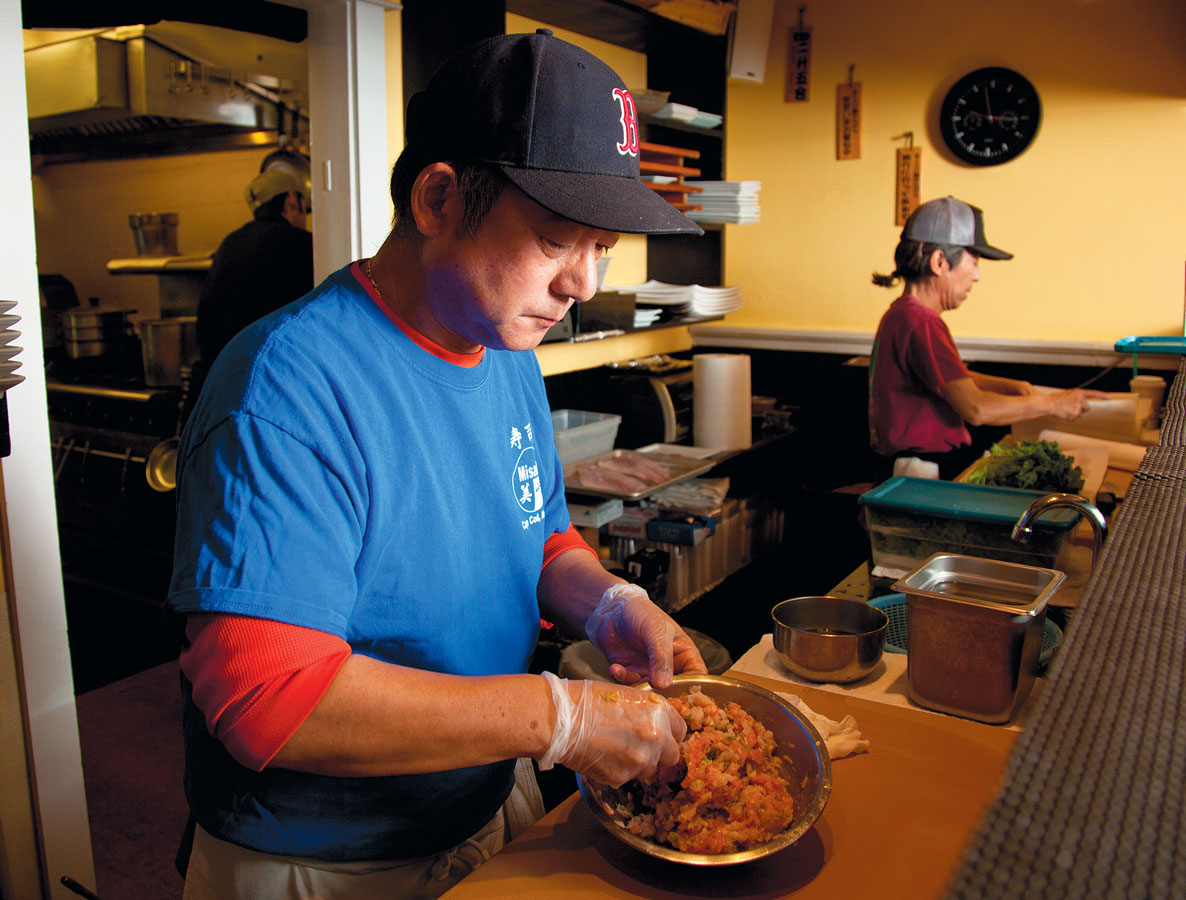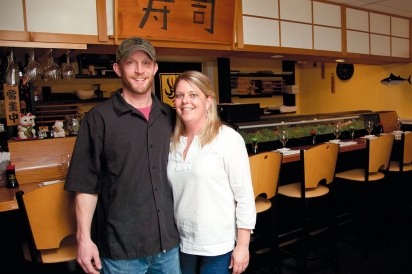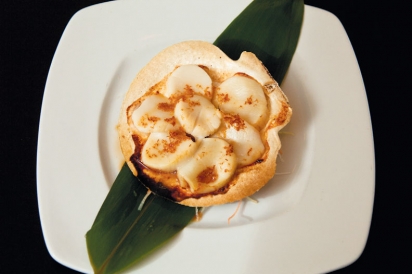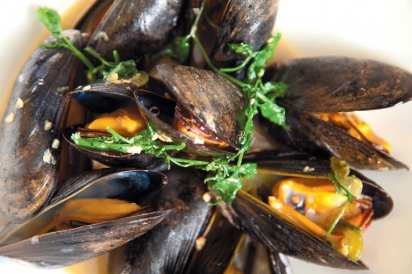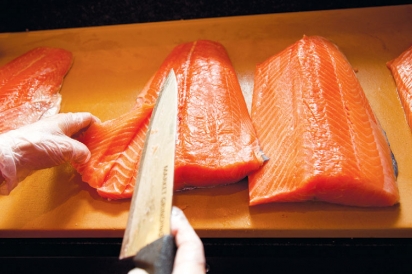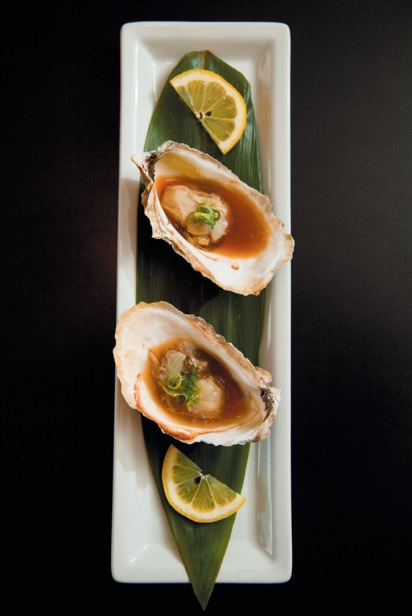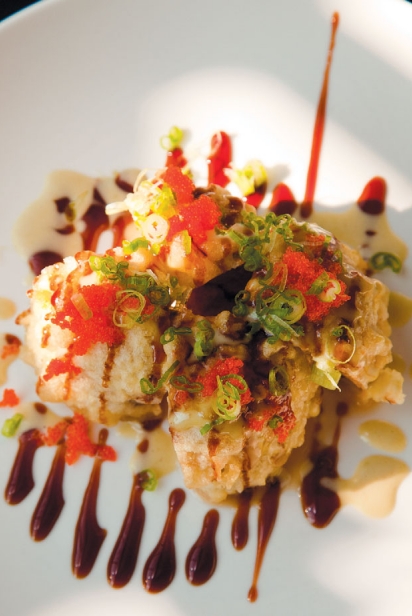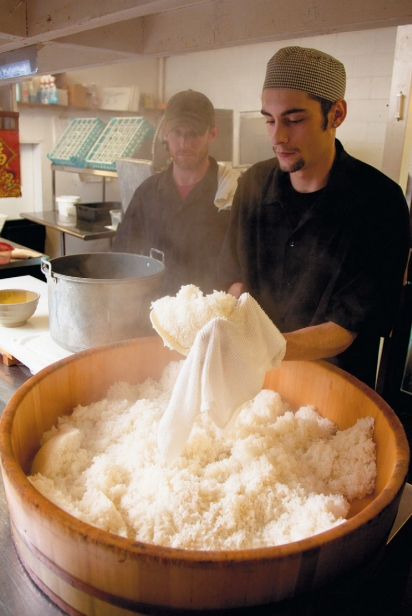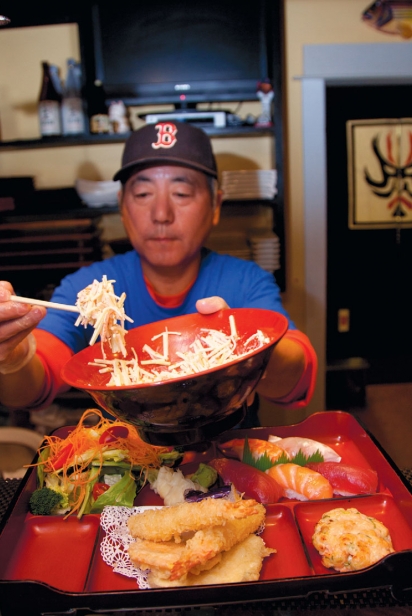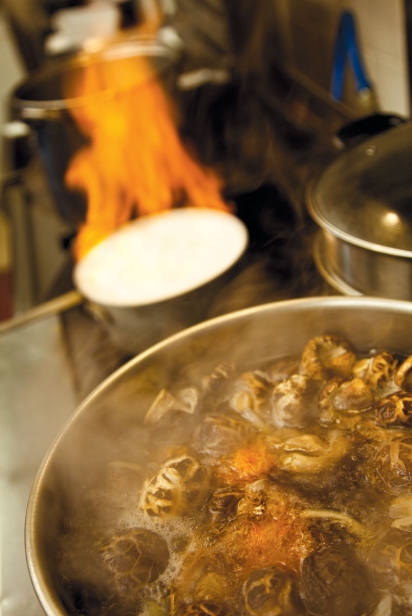Misaki Sushi
Through the Pass
If we hadn’t been looking for it, we would have missed it completely. Hidden on the side of a nondescript complex on Hyannis’ West Main Street, a portal awaits those in search of authentic Japanese cuisine.
For over a decade, Misaki has been one of the Cape’s best-kept secrets, attracting sushi fans from far and wide. Since taking over from the previous owner eight years ago, Karen and Sean Terrio have struck upon the simple ingredients for success: dedicated staff and high quality ingredients.
Head sushi chef Makoto “Hama” Hamada has been crafting delectable raw fish gems almost from the beginning, followed closely in seniority by sous chefs Eric Fenner, Akira Maeda, and Yuki Moritani. The restaurant’s welcoming, family atmosphere keeps Hamada and Maeda—who worked together in Tokyo before emigrating to the United States—commuting from Quincy, and leads to a consistently delicious experience for diners.
“We’ve tried hard to create a good environment for ourselves and the people who work here. We’re on a first-name basis with many of our customers,” Karen says. “It’s all about quality ingredients and quality of life.”
Eight years ago, the Terrios were on a much different path. Though both Karen and Sean were enrolled in a teaching program at UMass Boston, they didn’t meet until introduced by a mutual friend in Dennis. It turned out they had more than teaching in common. Both had grown up working in their family’s restaurants—Sean as a fry cook at a “standard American” joint in Whitman, Karen at two places in Yarmouth—and yearned to do something different at a place of their own.
The pieces fell into place when Karen’s father learned that the legendary Misaki was for sale. The numbers were right, the couple acknowledged, but they were mostly attracted to the chance to be part of an authentic food movement. “I think especially on the Cape, people crave the experience of tasting certain types of cuisine,” Karen says. “I don’t think we would have purchased an American restaurant. More than anything, we were looking for a challenge.”
Since taking the plunge, the Terrios have taken the challenges in stride. Sean, who doubles as back-of-the-house chef, has learned to order specialty ingredients in Japanese. He can also be found scouring the farmers’ market or nearby supermarkets in an effort to find produce at its prime. Cherry tomatoes, kale, and Japanese eggplant come from the Terrios’ own garden in the summer. The restaurant receives deliveries from Cape Fish & Lobster four times a week, and that includes locally-caught shellfish, striper, black sea bass, squid, mackerel and yellowtail tuna.
“It has to be fresh from start to finish. We’re very concerned about the quality of the food we eat, and it’s the same with what we serve,” Karen says.
The Terrios’ commitment to house-made quality is what gives Misaki its authentic taste. Although the menu features a few “fusion” items—such as the amazing tempura-fried, tuna-stuffed mushroom “monkeyballs” and the tuna carpaccio—the focus is on made-to-order sushi, calmly and confidently executed by Hamada.
With his Red Sox cap and twinkling eyes, Hamada’s manner suggests a major league baseball pitcher, deftly and lovingly shaping choice cuts of fish into balls that pack a serious punch. Hamada came to Boston in 1980 with a Tokyo-based restaurant company, relishing the chance to introduce Japanese cuisine to new people and be exposed to a new culture himself. He’s a fan of all the Boston sports teams except for the Bruins, because 30 years later, he still doesn’t understand the rules of hockey. While he says he prefers it in the U.S., Hamada goes back to Japan every few years to see family and check in with the latest food trends. Pulling out a cell phone, he shows us a video of a meal he enjoyed back home, featuring a still-live fish and a conch spewing smoke (it was filled with dry ice). Asked whether they’ll ever feature something like that at Misaki, Hamada and Maeda start laughing.
“I wouldn’t know what to do with a live fish. We like our fish dead!” Maeda chuckles, unwrapping a fresh filet.
With striper season warming up, we were tempted by the Cape Cod Inside Out roll, featuring striped bass and scallion. But we wanted our first striper of the season to be unadulterated, so went for a sashimi special instead. Sliced prosciutto-thin, the bass had a delicate ocean flavor that contrasted well with the intoxicating lemon-balm-like leaf accompanying it. A quick dip in the ponzu sauce and the fish went down smoothly, chased by a sip of cold cedar-accented taruzake sake.
This was more than enough to whet our appetites for the chef ’s sashimi selection on its way. Plated like exquisite French pastry, the artfully arranged morsels were treasures. The sea scallop nigiri, cut just minutes before from a live mollusk, was simply delicious, nutty and light. It was rivaled only by the other scallop dishes we sampled, served right in their shells: impeccable tidbits of scallop, octopus, and crab, slathered in dynamite sauce, or simply seared whole scallops topped with a delightful ginger-citrus sauce.
In comparison, the Black Jack maki was a study in decadence: a California roll with tempura asparagus and Cajun black pepper-encrusted tuna. Textures of tempura and seared tuna melded together for a perfect bite, finished with a salmon roe crunch and kick of sriracha at the end.
Those who shy away from raw fish have plenty to choose from at Misaki. We watched a table with young children put away a chicken teriyaki with gusto. The tempura is delectable: a light coconut-inflected batter enrobing still-crisp vegetables and sweetly delicate shrimp. On the day we dined, Sean tried a special featuring Wellfleet mussels that we hope will become a regular menu fixture. Incredibly fat meats swam in flavorful mirin-tinged broth that could be the best seafood medium I’ve ever tasted. The same could be said for the soyscallion elixir topping the freshly shucked and beautifully cupped Katama oysters.
Vegetarians will also not go hungry at Misaki. Our server raved about the agedashi (deep-fried) tofu, while the wild mushroom Misaki soup, tofu yaki soba or six-vegetable maki would also make delicious choices. If tempted by the vegetable gyoza, be sure to have them seared, not steamed.
Misaki appeals to more adventurous tastes with delicacies such as monkfish liver and yellowtail cheek sashimi (Hamachi kama), cut to order from whole fish. For an even more authentic taste of Japan, Karen recommends the omakase, five to seven small courses offered by reservation only for $70 per person.
“It’s literally like having a personal chef for a few hours. We shop exclusively for it, so there are a lot of unusual things like baby octopus or sea urchin that are out of the box,” Karen says.
Bento boxes, a selection of sushi, sashimi, and tempura based on the chef ’s choice, are so popular that Misaki can only offer them during the off-season, and even then only Tuesdays through Thursdays from 4:30 to 6 pm. With only four chefs on hand, the bento boxes are simply too time-consuming to offer more regularly, Karen says.
When they’re not doting on the sushi rice or slow-simmering the Misaki soup, the other chefs are busy with prep. Everything besides the soy sauce is made in-house, and the not-too-hot wasabi is made fresh daily. Asked for the ingredients to his legendary “dynamite sauce,” Sean is coy, but finally gave up a few of the 12 surprising ingredients: lemon, oregano, and mirin. The secret to his teriyaki Angus steak is in the sauce, Sean says, while adding a few pints of sake to a steaming pot of the stuff.
Speaking of sake, Misaki boasts a rare list of fine cold sakes. Those who peruse the liquor store aisles might recognize the sparkling, unfiltered, cedar-barrel-aged and citrus flavored varieties, but most of us are used to drinking rather mediocre brands, served hot. There’s a whole other level to sake to be experienced in the daiginjo (pear and apricot flavored with notes of pepper and sage) and the junmaiginjo, which is simply described as “mushroomy.” We enjoyed our sake neat, served in an elegant glass carafe, but it can also be mixed in a saketini, with plum wine, vodka, and cucumber garnish. Beer drinkers will delight in a variety of hoppy IPAs, which pair well with the cuisine, as well as the traditional Japanese brews Kirin and Sapporo. True Japanophiles will go for the 12-year Hibiki whiskey, so popular in Japan that imports are limited to this one brand.
Our meal ended on a sweet note in the form of a tamago—egg custard—roll, balanced on a bed of fragrant sushi rice. Chewy yet delicate, it rounded out a perfectly satisfying experience. Karen said that some customers save the tamago to eat for breakfast the next day. Perhaps they have more will power than we do.
Misaki Sushi
379 West Main Street, Hyannis
508-771-3771 / misakisushi.com
Dinner Tuesday-Saturday starting at 4:30 pm


